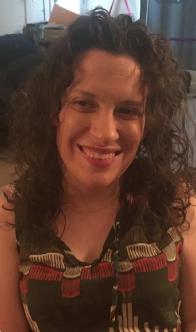News
NATIONAL ACADEMY FOR STATE HEALTH POLICY: National Strategy to Support Family Caregivers Progress and Impact Report 2024
By SD Network, 2024-11-25
|
The report lists hundreds of actions that federal agencies, state and local governments, businesses, and communities that can be taken to improve caregivers' lives. The strategy includes five goals: increase awareness and outreach, build partnerships and engagement with family caregivers, strengthen services and supports, ensure financial and workplace security, and expand data, research, and evidence-based practices. |

What's your story? Tell us a little bit about yourself.
Katrina shares that she lives with Cerebral Palsy and uses a power wheelchair for primary community mobility. She works at the University of Minnesota-Twin Cities Institute on Community Integration. She lives independently in an apartment and utilizes Home and Community Based Services to do so.
Katrina is the coordinator of the Self Advocacy Action committee at ICI. She explains that the purpose of that committee is to make sure that all of the policy and research products produced at the institute are “vetted” by individuals who live with Intellectual and Developmental Disabilities. “We meet once per month and focus on a specific product. All are welcome at our meetings,” she tells us.
How are you involved with self-determination? Why did you join the SD Network?
Katrina explains that their mission as a committee is to improve self-determination (and the knowledge base around it) for people living with I/DD and other disabilities. She joined this network to become more connected to similar efforts and to learn about best practices around self-determination.
Tell us some good news - what's the most exciting thing happening for you (or in Wisconsin) in terms of self-determination?
Katrina is just now finishing a class that is focused on lived experience partnerships for research outcomes in Cerebral Palsy. “I am excited to hopefully become more involved in that work in the future,” she says.
What tip or resource would you like to share with people who want to be more self-determined?
Katrina encourages people who want to be more self-determined to educate themselves about the choices available and the topic that they care about. Knowing what options are available is really important in self-determination.
What are some of your hobbies?
In her spare time, Katrina loves going to Target and playing video games. She also loves helping people. “One time I got to help someone pick out a video game at Target. It was a really great day,” she exclaims!
***We love hearing the views and opinions of Network members. We need to mention that the views and opinions expressed on this site are those of the person who is sharing them. They do not necessarily reflect InControl Wisconsin or any of our supporters and funders.
THE NATIONAL CONFERENCE FOR STATE LEGISLATORS: Workforce Shortages Top the List of Health Policy Priorities
By SD Network, 2024-11-22
State legislatures passed over 3,000 health policy bills in 2024, focusing on healthcare workforce shortages, Medicaid changes, and youth mental health. Key actions included recruiting behavioral health workers, expanding Medicaid services, and addressing rising youth mental health concerns. AI in healthcare and drug affordability emerged as new priorities.
Many people with disabilities prefer to self-direct their care. Yet, because overall enrollment and awareness remain relatively low. There are many misconceptions about self-direction. This is an interesting opinion article trying to debunk some of the myths about self-direction.
FAMILY VOICES OF WI: Circles of Life Conference Exhibitor & Sponsorship Opportunities
By SD Network, 2024-11-13
|
|||||||||||||||||||||||||||||||||||||||||||||
|
|||||||||||||||||||||||||||||||||||||||||||||
|
|
|||||||||||||||||||||||||||||||||||||||||||||
|
|||||||||||||||||||||||||||||||||||||||||||||
|
|||||||||||||||||||||||||||||||||||||||||||||
|
|
|||||||||||||||||||||||||||||||||||||||||||||
|
|||||||||||||||||||||||||||||||||||||||||||||
|
|
|||||||||||||||||||||||||||||||||||||||||||||
|
|||||||||||||||||||||||||||||||||||||||||||||
|
|||||||||||||||||||||||||||||||||||||||||||||
|
|||||||||||||||||||||||||||||||||||||||||||||
|
|
|||||||||||||||||||||||||||||||||||||||||||||
|
|||||||||||||||||||||||||||||||||||||||||||||
|
|||||||||||||||||||||||||||||||||||||||||||||
|
|||||||||||||||||||||||||||||||||||||||||||||
KAISER FAMILY FOUNDATION: Who are the direct care workers providing long-term services and supports (LTSS)?
By SD Network, 2024-11-03
This analysis uses the 2022 American Community Survey to provide an overview of demographic characteristics, wages, and health insurance coverage of direct care workers, which include home health aides, personal care aides, nursing assistants, licensed practical nurses (LPNs), and registered nurses (RNs).
KAISIER FAMILY FOUNDATION: Experiences of direct care workers and family caregivers of home- and community-based services (HCBS)
By SD Network, 2024-11-03
This issue brief presents findings from focus groups with direct care workers and unpaid caregivers who provide HCBS including caregiver characteristics; physical, emotional, and mental caregiving demands of caregiving; their wages, finances, and opportunities for advancement; and what caregivers would like policymakers to know about their work.
CBSNEWS: American Airlines to pay record $50 million fine over its treatment of disabled passengers
By SD Network, 2024-11-03
American Airlines has agreed to a record $50 million settlement with the U.S. Department of Transportation for violating laws that protect airline passengers with disabilities. They are also accused of damaging thousands of wheelchairs from 2019 to 2023. The airline came under fire after a video of crew members mishandling a passenger's wheelchair went virtual.
|
|

What's your story? Tell us a little bit about yourself.
Peter is 37 years old and lives with cerebral palsy. He works in the contact center at Exact Sciences. He explains that he has always been passionate about advocating for individuals with disabilities, striving to improve their lives so they can achieve independence and thrive comfortably. His journey in self-advocacy began in childhood when he wrote to the school superintendent, urging her to install automatic door buttons.
He shares that as he has grown older, he’s witnessed firsthand the positive impact advocacy can have for people with disabilities. “I am committed to ensuring that everyone has the opportunity to pursue the American dream,” he tells us. In addition to his advocacy work, he’s an avid Green Bay Packers fan and enjoy all Wisconsin sports. He also loves connecting with people through meaningful conversations, where each person can share their unique story.
How are you involved with self-determination? Why did you join the SD Network?
Peter is the founder of an organization called Squeaky Wheel, dedicated to promoting self-determination for individuals with disabilities through technology. Their mission is to provide diverse communication tools and engage people with various disabilities in meaningful activities.
He’s passionate about reaching out to businesses and organizations to raise awareness about Squeaky Wheel and help them understand how they can enhance accessibility. This includes reducing physical barriers, creating screen readers for individuals who are blind or visually impaired, and developing tactile solutions for those on the autism spectrum. He explains that they aim to create a more inclusive environment for people with sensory sensitivities.
In the future, he explains that Squeaky Wheel will evolve into a social network where users can discover accessible vacation destinations. Businesses will also be able to leverage Squeaky Wheel to develop solutions and set accessibility goals. Ultimately, Squeaky Wheel will empower individuals to achieve self-determination and transform our perspective on accessibility in the world.
Tell us some good news - what's the most exciting thing happening for you (or in Wisconsin) in terms of self-determination?
Peter recently relocated from Arizona back to Wisconsin to be closer to his family and friends. “Having a strong support system enables me to live more independently and positively impacts my mental health, providing me with comfort and encouragement,” he says.
What tip or resource would you like to share with people who want to be more self-determined?
Peter shares that he has always relied on Access to Independence (an Independent Living Center) to stay informed about developments in the accessibility community. “They are well-connected within the Madison area and recently organized an accessibility gaming convention, among many other activities they promote,” he explains.
What are some of your hobbies?
In his spare time, Peter enjoys playing video games, going to Green Bay Packers games, and going out with friends. He tells us that he has gotten into podcasting as well and enjoys being able to share his opinions and views.
***We love hearing the views and opinions of Network members. We need to mention that the views and opinions expressed on this site are those of the person who is sharing them. They do not necessarily reflect InControl Wisconsin or any of our supporters and funders.
